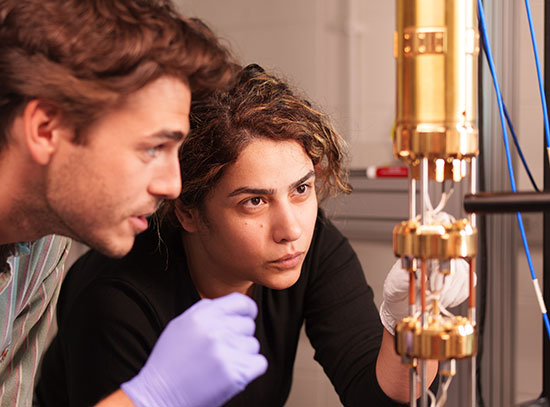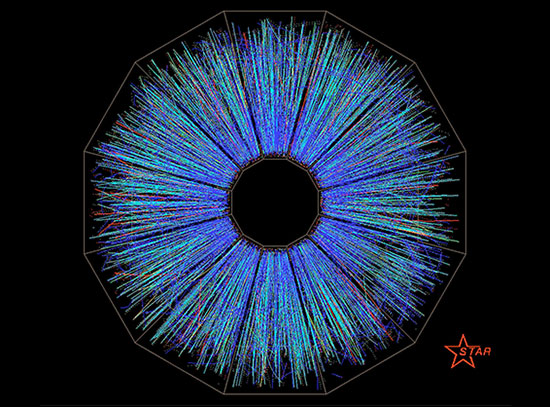MEDIA ADVISORY: First-of-its-kind Electron-Ion Collider (EIC) Takes Shape as Relativistic Heavy Ion Collider (RHIC) Enters Final Run
February 25, 2025
 enlarge
enlarge
The Electron-Ion Collider (EIC) will make use of existing components of Brookhaven's Relativistic Heavy Ion Collider (RHIC), including its ion sources, pre-accelerator chain, and one of its superconducting magnet ion storage rings. We'll add an electron source and accelerator components outside the tunnel and a new electron storage ring inside the tunnel so that collisions can take place at points where the stored ion and electron beams cross. (Valerie Lentz/Brookhaven National Laboratory)
WHAT: Meet scientists who are exploring how the fundamental building blocks of matter behaved in the early universe and are seeking to understand how those building blocks interact within the visible matter of today’s world. This Press Roundtable at the American Physical Society’s Global Physics Summit will feature brief remarks from scientists conducting research at the Relativistic Heavy Ion Collider (RHIC), a U.S. Department of Energy (DOE) Office of Science user facility for nuclear physics research at DOE’s Brookhaven National Laboratory, and preparing to transform RHIC into an Electron-Ion Collider (EIC). The EIC will be a unique machine filled with state-of-the-art technologies for exploring the inner workings of the building blocks of matter and the strongest force in nature.
DATE: Monday, March 17, 2025
TIME: 3:30-4:30 p.m. PDT
WHERE: APS Global Physics Summit Newsroom
Manhattan Room of the Hilton Anaheim
777 West Convention Way
Anaheim, California 92802
BACKGROUND: The final run is about to start at the Relativistic Heavy Ion Collider (RHIC) — a particle collider that’s been smashing atoms at Brookhaven National Laboratory since 2000. RHIC’s collisions recreate the conditions of the early universe so scientists can study quarks and gluons, the building blocks of visible matter, as they existed some 14 billion years ago.
At RHIC, nuclear physicists have learned a lot about the hot soup of quarks and gluons that eventually coalesced to form the protons and neutrons of atomic nuclei — the bulk of visible matter in our universe. And they’ve gained insight into how these fundamental particles contribute to proton spin. But they want to learn more — particularly how quarks and gluons interact within the matter that makes up our world today and how their arrangements and interactions within protons and nuclei influence what’s been observed in other experiments, including at RHIC.
For that, Brookhaven Lab will be transforming RHIC into a brand-new machine, an Electron-Ion Collider (EIC), with the help of experts at DOE’s Thomas Jefferson National Accelerator Facility (Jefferson Lab) and collaborators around the world. The EIC will conduct precision studies of the internal structure of protons and atomic nuclei to explore the force that governs the properties of all visible matter. It will be one of the most exciting — and most challenging — accelerator projects ever constructed.
This APS Press Roundtable, open exclusively to Global Physics Summit newsroom attendees, will cover the scientific foundations for building the EIC and introduce you to state-of-the-art accelerator, detector, and data technologies that will bring this machine and its discoveries to life. The roundtable will feature brief introductory remarks followed by open discussion and Q&A.
SPEAKERS AND TOPICS
Zhoudunming (Kong) Tu, Brookhaven National Laboratory
What we’ve learned at RHIC about “quark-gluon plasma” and proton spin, and the goals of the final RHIC run
Maria Zurek, Argonne National Laboratory
How the EIC will build on, add precision to, and go beyond RHIC discoveries (main EIC science goals)
Daniel Marx, Brookhaven National Laboratory
EIC accelerator overview, including the challenges of building a machine with technologies and capabilities that go beyond any other accelerator in the world
Miguel Arratia, University of California, Riverside
Overview of the EIC detector (ePIC), including breakthroughs in technology that will advance precision measurements and EIC science
David Dean, Thomas Jefferson National Accelerator Facility
How AI will drive EIC design and discovery plus spinoffs of streaming EIC data to share it seamlessly with collaborators around the world
EIC Science Director Abhay Deshpande (Brookhaven Lab and Stony Brook University) will also be on hand to answer questions and discuss additional benefits, including educational opportunities and skilled workforce development, how RHIC and the EIC enable the operation of space radiation research and isotope production facilities at Brookhaven Lab, and applications of EIC accelerator and detector technologies to other fields.
PRESS REGISTRATION
Members of the media (staff journalists, freelancers, public information officers, and students/postdocs enrolled in science writing programs) can register for the APS Global Physics Summit at no cost to attend this event. Sign up for APS press credentials to verify eligibility. For questions, please contact the APS media team.
Related links
Fact sheets: EIC Science Overview, EIC Project Update
Select stories about RHIC and the EIC:
- Welcoming a New Era of Discovery at the 2024 RHIC & AGS Users' Meeting
- Accelerator Experiments at RHIC Inform EIC Design
- All Eyes on EIC at IPAC'24 and in Rome as World Partners Gather
- Key Partners Mark Launch of Electron-Ion Collider Project
- The Glue that Binds Us All
Brookhaven Lab’s Flickr albums: RHIC, EIC
Interactive EIC website: Explore the Electron-Ion Collider
Social media: Follow @BrookhavenLab on social media. Find us on Instagram, LinkedIn, X, and Facebook. If you post about this event, please consider adding the following hashtags: #RHIC #ElectronIonCollider
MEDIA CONTACTS
Karen McNulty Walsh, Brookhaven National Laboratory
kmcnulty@bnl.gov
631-344-8350
Kandice Carter, Thomas Jefferson National Accelerator Facility
kcarter@jlab.org
Brookhaven National Laboratory, Thomas Jefferson National Accelerator Facility, RHIC, and the EIC Project are supported primarily by the U.S. Department of Energy Office of Science. The Office of Science is the single largest supporter of basic research in the physical sciences in the United States and is working to address some of the most pressing challenges of our time. For more information, visit science.energy.gov.
2025-22325 | INT/EXT | Newsroom









